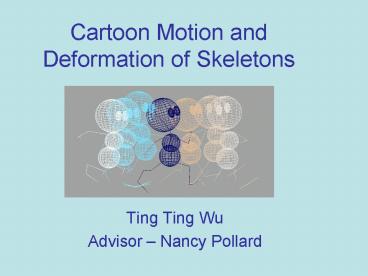Cartoon Motion and Deformation of Skeletons - PowerPoint PPT Presentation
Title:
Cartoon Motion and Deformation of Skeletons
Description:
Cartoon Motion and Deformation of Skeletons Ting Ting Wu Advisor Nancy Pollard Background/Motivation Background/Motivation Cartoon Motion and Deformation of ... – PowerPoint PPT presentation
Number of Views:93
Avg rating:3.0/5.0
Title: Cartoon Motion and Deformation of Skeletons
1
Cartoon Motion and Deformation of Skeletons
- Ting Ting Wu
- Advisor Nancy Pollard
2
Background/Motivation
Which looks more interesting?
3
Background/Motivation
Which looks more interesting?
Most people pick this one
- Anticipation and Follow-through - Stretch and
Squash
4
2 Ways to Apply Stretch and Squash - posture -
body parts/limbs
(PowerPoint didnt like video clip)
5
Stretch and Squash in 3D
- used extensive for postures
- hardly used at all for limbs
6
Stretch and Squash in 3D
- used extensive for postures
- hardly used at all for limbs
well one notable exception
7
Stretch and Squash in 3D
- used extensive for postures
- hardly used at all for limbs
8
Goal
Add cartoony-ness into motion-captured data or
key-framed data
9
Goal
Add cartoony-ness into motion-captured data or
key-framed data 2 Ways to approach this - using
a physical system to model skeleton
deformations get different deformations by
changing a few intuitive
variables (mass, springyness) - using a filter
that only looks at motion curves more aligned
with original 2D animation methods (?)
10
Physical System - Initial Steps
- Rotoscoped Mickeys walk in Maya
- Motion-captured an actor mimicking Mickeys walk
- (videos)
11
Bone Lengths
Here are the main bones that change lengths to
contribute to expression.
12
Bone Lengths
Here are the main bones that change lengths to
contribute to expression.
Mass at thorax
Anchor at upperback
Mass at root
13
Variables
Each spring abides by this equation. f ma
-kd bv Where d length springs rest
length k spring stiffness coefficient b
damping coefficient
length
14
(No Transcript)
15
Cartoon Motion and Deformation of Skeletons
- Ting Ting Wu
- Advisor Nancy Pollard
16
Background/Motivation
Which looks more interesting?
17
Background/Motivation
Which looks more interesting?
Most people pick this one
- Anticipation and Follow-through - Stretch and
Squash
18
2 Ways to Apply Stretch and Squash - posture -
body parts/limbs
(PowerPoint didnt like video clip)
19
Stretch and Squash in 3D
- used extensive for postures
- hardly used at all for limbs
20
Stretch and Squash in 3D
- used extensive for postures
- hardly used at all for limbs
well one notable exception
21
Stretch and Squash in 3D
- used extensive for postures
- hardly used at all for limbs
22
Goal
Add cartoony-ness into motion-captured data or
key-framed data
23
Goal
Add cartoony-ness into motion-captured data or
key-framed data 2 Ways to approach this - using
a physical system to model skeleton
deformations get different deformations by
changing a few intuitive
variables (mass, springyness) - using a filter
that only looks at motion curves more aligned
with original 2D animation methods (?)
24
Physical System - Initial Steps
- Rotoscoped Mickeys walk in Maya
- Motion-captured an actor mimicking Mickeys walk
- (videos)
25
Bone Lengths
Here are the main bones that change lengths to
contribute to expression.
26
Bone Lengths
Here are the main bones that change lengths to
contribute to expression.
Mass at thorax
Anchor at upperback
Mass at root
27
Variables
Each spring abides by this equation. f ma
-kd bv Where d length springs rest
length k spring stiffness coefficient b
damping coefficient
length
28
Variables
Each spring abides by this equation. f ma
-kd bv Multiple Linear Regression to get k
and b! Should contain the springyness of
Mickeys walk. Ideally, this should allow us to
transfer the same kind of stretching and
squashing to another moving skeleton.
length
29
Some of the Data
Plots of d
30
Some of the Data
Plots of force acting on spring































